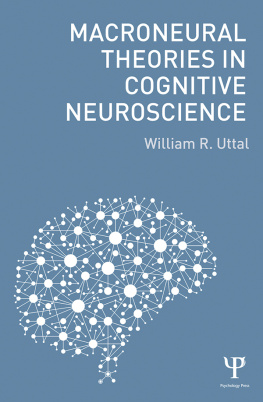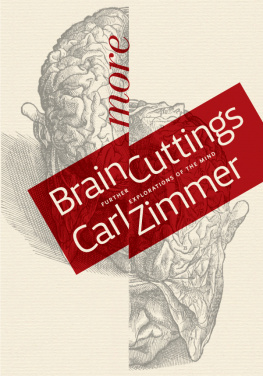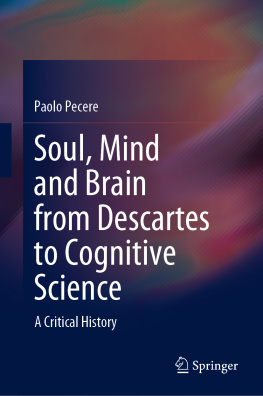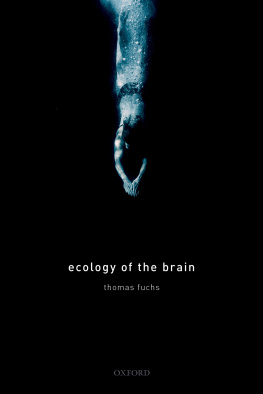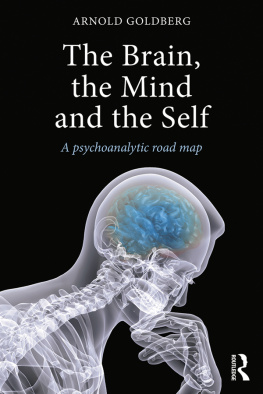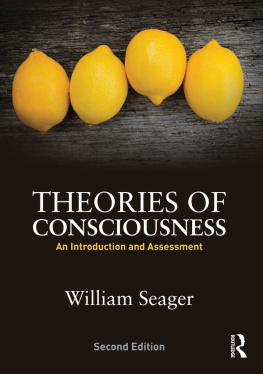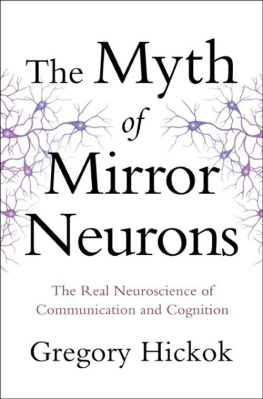The right of William R. Uttal to be identified as author of this work has been asserted by him in accordance with sections 77 and 78 of the Copyright, Designs and Patents Act 1988.
All rights reserved. No part of this book may be reprinted or reproduced or utilised in any form or by any electronic, mechanical, or other means, now known or hereafter invented, including photocopying and recording, or in any information storage or retrieval system, without permission in writing from the publishers.
The ultimate goal of cognitive neuroscience is to explain how brain activity produces mental activity. In other words, it is to provide an answer to the ageold mind-body problem, now particularized as the mind-brain problem. Without attaching too much hyperbole to the discussion, it is fair to say that we are asking what may be considered to be the preeminent conundrum of human intellectual historyhow does the material brain create the intangible sense of conscious awareness shared by humans and provide for the adaptive cognitive processes that guide our experiences and our behavior? In its extreme complexity, this problem crosses over a vast range of intellectual and scientific disciplines including theology, philosophy, mathematics, statistics, and biology, as well as certain fields of psychology.
The answers to this awe-inspiring question have ranged from dualistic concepts asserting that the mental and neural domains were distinctly different kinds of reality to those arguing that mind is simply an irrelevant byproduct or epi-phenomenon of neuronal activity to modern monist, physicalist, and neuroreductionist identity theories. However, the basic idea guiding current scientific thinking is that whatever mind is, it is nothing more (or less) than an outcome, product, or activity of the material nervous system. Thus, it has been argued that to understand the mind requires that we understand the brain. Indeed, some philosophers even have argued that the definitions and methods of psychology are only temporary substitutes for the ultimate neurophysiological explanations of mind and behavior; neurophysiology, they argued (e.g., Churchland, 1981), will ultimately replace psychological languages, descriptions, theories, and explanations. Obviously, we are nowhere near such an eliminative explanation, but the point is made in principle. In practice, however, such eliminative solutions are at best the hope of some distant future.
Unfortunately, the problem of reducing psychological constructs to neuro-physiological mechanisms has turned out to be far more complex and difficult than originally anticipated. Even the newest and most powerful techniques to study brain anatomy, physiology, and cognitive processes hardly have begun to unravel the world knotthe expression of the mind-brain problem attributed to Arthur Schopenhauer (17881860). We now know that, beyond its importance, the problem is exceedingly complex. Not only is the brain an intricate network of idiosyncratically interconnected neurons, but also cognition is inadequately defined by such words as mind, thinking, consciousness, and a host of other terms used by psychologists.
This book is concerned with a special aspect of modern cognitive neuroscience theorythe linkage of the findings obtained with macroscopic responses of the brain to human thought processes. It is a sequel to my earlier work Neural Theories of Mind (Uttal, 2005), in which I asked similar questions for electric fields, single cells, and neural networks. The answer to which I have arrived is that, for the time being at least, there is no theoretical pathway to answering this question with brain imaging techniques. Although I plan to be as unbiased as possible and present to the extent possible both sides of the question, I must acknowledge that I have concluded that an overarching mind-brain theory is no more likely to arise from any current conceived macroneural approach.
This book is aimed at exploring the role of current macroneural theory in cognitive neuroscience and making the case for its impenetrability. To understand how we might contribute to this discussion, it is necessary to consider what a theory is in general as well as in the particular context of cognitive neuroscience. Over the years, I have explored questions such as the following:
- What are the properties of a robust theory relating mind and brain?
- What kinds of mind-brain theories exist?
- What is an acceptable theory at the macroneural level of brain images?
- What assumptions have to be made in formulating a modern theory?
- What are the conditions of necessity and sufficiency that make a theory or law acceptable?
- Can neural data inform cognitive theory?
- Can cognitive data inform neural theory?
- How do description and explanation differ?
- What is the relation between simulation models to the processes they imitate?
- How can analogies mislead us into assuming that processes drawn from the psychological and neurophysiological levels are homologous rather than just analogous, coincidental, or correlative?
- What kind of a balance can be established between achievable pragmatic concerns (medical practice) and what may be logically unachievable biopsy-chological theories?
- Which so-called theories are only superficial restatements of a priori postulates, intuitions, experimental results, or anecdotal observations?
- Finally, for cognitive neuroscience, the big question is: Are the data of cognitive neuroscience sufficiently objective, regular, reliable, robust, and far reaching so that a comprehensive theory of mind-brain relations can be constructed from them? Can we look forward to theories that are as well structured, axiomatic, and deductive as are those found, for example, in physics? In other words, are the barriers to developing reductive theories to bridge between the mental and the neurophysiological tractable or intractable?
Obviously, not all of these questions can be resolved within the pages of a single book. Furthermore, it may turn out that some of these questions (e.g., the level of instantiation) may not be answerable in a rigorous fashion; answers being denied by virtue of their complexity or other empirical barriers. However, it seems likely that at least a continuing effort to explore the parameters of what an overarching theory should be like might begin to provide at least a glimmering of answers to some of the questions in this list.
A major issue confronting the theoretician and the experimentalist is the level at which the problem is attackedthe macroneural or the microneuronal. Each has its own difficulties. The macroneural approach is complicated by the cumulative nature of their findings and, thus, the loss of detailed information about the activity of individual neurons. The microneuronal approach, on the other hand, is complicated by the sheer numerousness of the idiosyncratically involved components underlying cognitive activity and their complex interactions. Given these difficulties, there remains a great deal of uncertainty and controversy about what the actual nature of the mind-brain relation is. When interrogated, however, I think that most cognitive neuroscientists would accept the Hebbian (Hebb, 1949) microneuronal answer to the question of the level at which the meaningful neural responses are located in the brain. This widely accepted answer is that it is the information transformation processes collectively carried out by innumerable individual neurons, each of which acts as a part of a heavily and idiosyncratically interconnected network, is most likely to be the source of our thoughts, minds, consciousness, cognitive processes, or whatever term one might wish to use. However, it is also probably true that the complexity and numerousness characterizing the interactions among neurons capable of encoding cognition or consciousness is probably beyond our current ability to study empirically because of simple combinatorial constraints despite current progress on the development of powerful supercomputers. Yet, however plausible and relevant this level of analysis may seem to be, it must be remembered that there is only the beginnings of an empirical foundation for the Hebbian model. No one has ever either manipulated the microdetails of the individual states of the neuronal components of a realistic microneuronal network in a way that controls thoughts. Nor has anyone ever observed the details of how a realistic microneuronal network changes with changes in our mental states. Simulations of the relation between neuronal networks abound, but the microneuronal bridge to cognition remains largely uncrossed. (Some progress in dealing with the cumulative states of neuronal networks of the amygdala does, however, suggest that progress is being made in this direction. See Nabavi et al., 2014)

